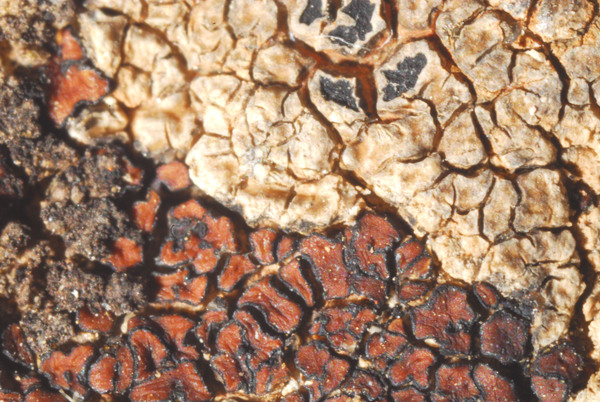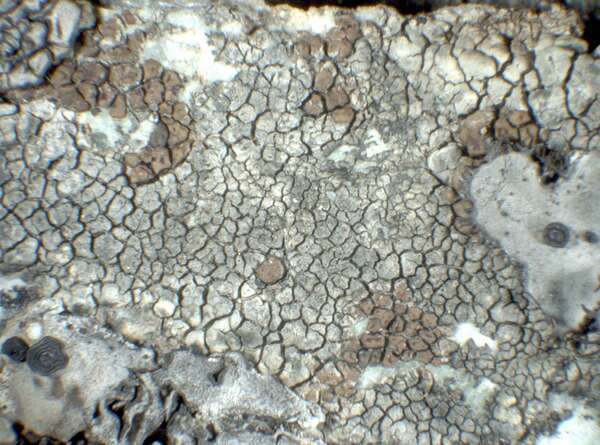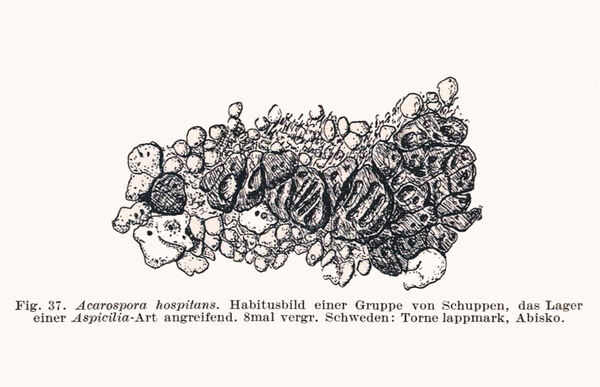Acarospora hospitans H. Magn.
Göteb. Vetensk.-och Vitter.-Handl., ser. 4, 28, 2: 111, 1924.
Synonyms: Acarospora impressula var. hospitans (H. Magn.) Clauzade & Cl. Roux
Distribution: N - TAA (Pl. Graec. Lich. 182), Piem (TSB 34163), Emil (Fariselli & al. 2020). C - Sar (Brackel & Berger 2019). S - Bas (Nimis & Tretiach 1999), Cal (Puntillo 1996), Si (Poli & al. 1995, Nimis & al. 1996b, Grillo & Caniglia 2004, Brackel 2008c).
Description: Thallus crustose, episubstratic, chestnut brown, areolate-subsquamulose, forming small islands or lines on the thalli of other crustose lichens, the areoles dispersed or contiguous, to 1.5 mm wide, smooth, usually slightly glossy, flat or moderately convex; lower side dark brown to black along margins. Upper cortex 20-30(-50) µm thick, overlain by a thin amorphous layer; algal layer continuous; medulla white, inspersed with crystals. Apothecia lecanorine, often elongate, 0.1-1.5 x 0.1-1.2 mm, immersed in the areoles, usually 2-5 per areole, with a brown, concave to flat disc, and a thin, more or less prominent thalline margin. Proper exciple 15-20 µm thick; epithecium red-brown; hymenium colourless, 50-75 µm high, amyloid, 1+ persistently blue; paraphyses 2-2.5 µm thick, the apical cells 3-3.5 µm wide; hypothecium colourless, c. 30 µm high. Asci c. 100-spored, clavate, the apical dome K/I-. Ascospores 1-celled, hyaline, broadly ellipsoid, 3-5 x 2-3 µm. Pycnidia immersed. Conidia ellipsoid, 1-2 x 0.7-1.5 µm. Photobiont chlorococcoid. Spot tests: cortex and medulla K-, C-, KC-, P-, UV-. Chemistry: without lichen substances. Note: on siliceous rocks, growing on the thalli of other crustose lichens, according to Roux (in litt.) exclusively on Aspicilia spp. Much overlooked, and in need of further study, this species, which is apparently similar to A. impressula, does not belong to Acarospora s.str. (Westberg & al. 2015).
Growth form: Crustose
Substrata: rocks
Photobiont: green algae other than Trentepohlia
Reproductive strategy: mainly sexual
paras Aspicilia spp.
Poorly known taxon in need of further study
Commonnes-rarity: (info)
Alpine belt: rare
Subalpine belt: rather rare
Oromediterranean belt: very rare
Montane belt: rare
Submediterranean belt: extremely rare
Padanian area: absent
Humid submediterranean belt: absent
Humid mediterranean belt: absent
Dry mediterranean belt: absent

Predictive model
Herbarium samples
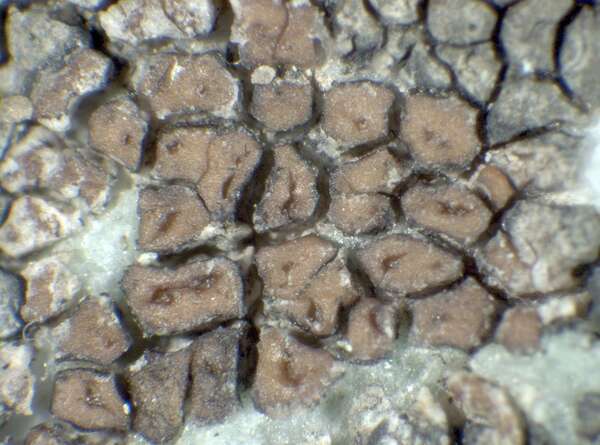

P.L. Nimis; Owner: Department of Life Sciences, University of Trieste
Herbarium: TSB (35208)
2002/07/09
on the host, Aspicilia sp.
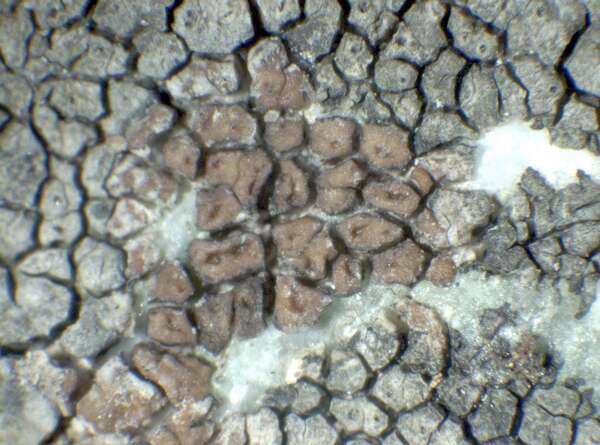

P.L. Nimis; Owner: Department of Life Sciences, University of Trieste
Herbarium: TSB (35208)
2002/07/09
on the host, Aspicilia sp.
Growth form: Crustose
Substrata: rocks
Photobiont: green algae other than Trentepohlia
Reproductive strategy: mainly sexual
paras Aspicilia spp.
Poorly known taxon in need of further study
Commonnes-rarity: (info)
Alpine belt: rare
Subalpine belt: rather rare
Oromediterranean belt: very rare
Montane belt: rare
Submediterranean belt: extremely rare
Padanian area: absent
Humid submediterranean belt: absent
Humid mediterranean belt: absent
Dry mediterranean belt: absent

Predictive model
| Herbarium samples |


P.L. Nimis; Owner: Department of Life Sciences, University of Trieste
Herbarium: TSB (35208)
2002/07/09
on the host, Aspicilia sp.


 Index Fungorum
Index Fungorum
 GBIF
GBIF
